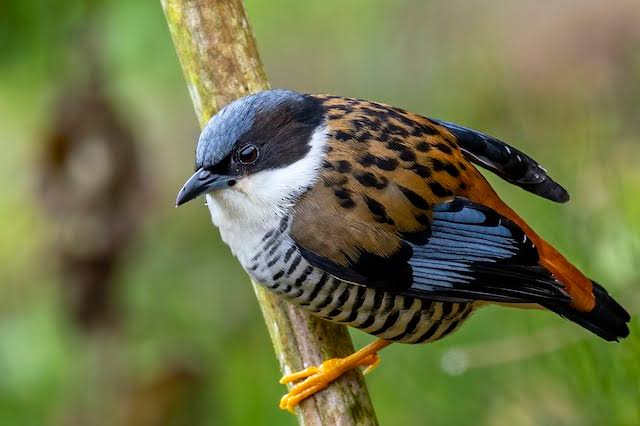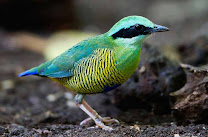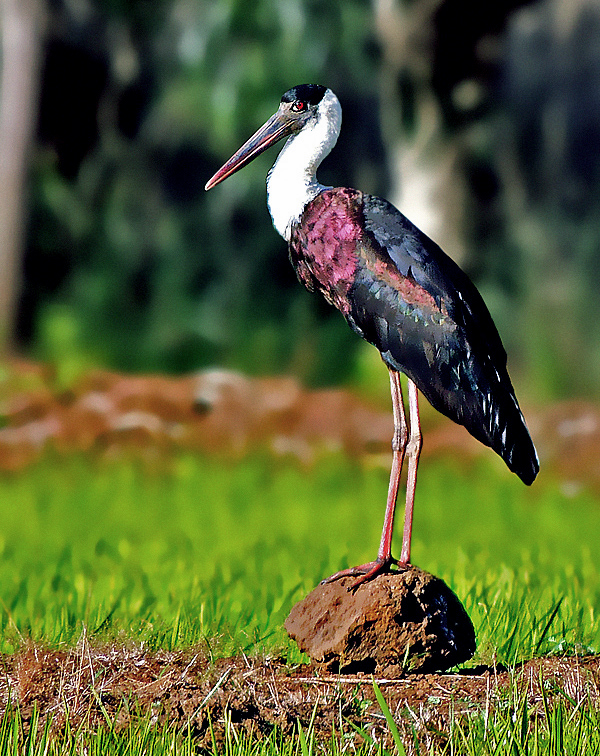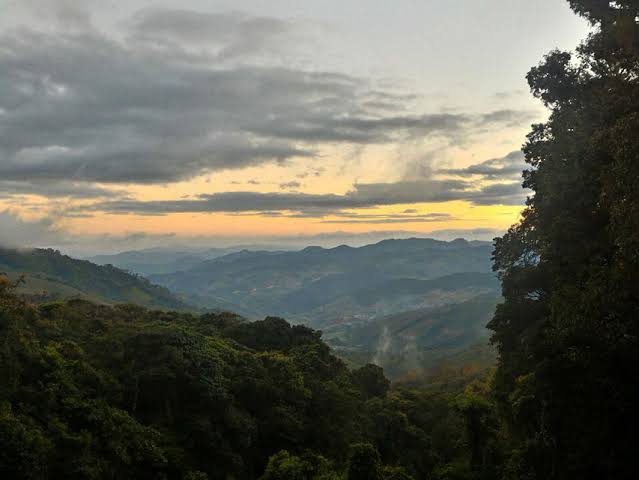Itinerary :
.
· Day 1: Cat Tien National Park (10Feb2023)

The natural area of Cat Tien National Park is 71.920ha wide including the South of Cat Tien (Dong Nai province) 39.627ha; Cat Loc (Lam Dong province) 27.850ha; the West of Cat Tien (Binh Phuoc province 4.4431-ha).
Cat Tien National Park is part of the wet tropical forest complex and one of the specious natural forests remaining in Vietnam. That is why this area is significant not only in Vietnam but in the world as well. The diversity of the Park has been recognized by WWF when this international organization selected the Park as one of 200 global ecological zones including the land and its water area with its wellknown biological diversity. In 2001 Cat Tien National Park has been listed by UNESCO as the 411th biosphere Reserve Zone in the world.
Lyriothemis pallidistigma, Kompier & Holden & Makbun, 2021
And Two new Rhinocypha species from Cat Tien National Park
 |
| Male Rhinocypha fulgipennis, courtesy of James Holden |
 |
| Brilliant Rhinocypha seducta, courtesy of James Holden |
· Day 2: Cat Tien National Park (11Feb2023)
Mammals
The park hosts many mammal species; the following may be encountered:[11]
Primates include the endemic golden-cheeked gibbonNomascus gabriellae
- black-shanked douc langurs Pygathrix nigripes
- Indochinese lutung (silvered langur) Trachypithecus germaini
- stump-tailed macaque (=bear macaque) Macaca arctoides
- crab-eating macaque (=long-tailed macaque) Macaca fascicularis
- northern pig-tailed macaque Macaca leonina
- pygmy slow loris Nycticebus pygmaeus
Scandentia ("tree shrews", family Tupaiidae: more related to primates than shrews):
- Dendrogale murina - Northern smooth-tailed treeshrew
- Tupaia belangeri - Northern treeshrew

Carnivores:

- sun bear Helarctos malayanus
- asiatic black bear Ursus thibetanus (in the bear sanctuary: but wild status is debated)
- Large-toothed Ferret Badger Melogale personatapierrei
- Yellow-throated Marten Martes flavigula subsp. indochinensis
- oriental small-clawed otter Aonyx cinerea
- crab-eating mongoose Herpestes urva
- binturong civet Arctictis binturong
- large Indian civet Viverra zibetha
- Asian Palm Civet Paradoxurus hermaphroditus
- small-toothed palm civet Arctogalidia trivirgata
- leopard cat Prionailurus bengalensis
Bats (confirmed records):
- fruit bats Pteropodidae 4 spp.
- false vampire bats Megadermatidae 2 spp.
- horseshoe bats Rhinolophidae 5 spp.
- leaf-nosed bats Hipposideridae 3 spp.
- evening bats Vespertilionidae 12 spp.
Rodents and Lagomorphs - the Park list includes:
- squirrels Sciuridae 5 spp.
- mice & rats Muridae 14 spp.
- porcupines Hystricidae:
- east Asian porcupine Hystrix brachyura
- brush-tailed porcupine Atherurus macrourus
- the Siamese hare Lepus peguensis (Lagomorpha: Leporidae)
Other notable mammal species, including some that are vulnerable or endangered, include:
- Sunda flying lemur (colugo) Galeopterus variegatus
- Asian elephant Elephas maximus (Proboscidea) - EN
- Sunda pangolin Manis javanica (Pholidota) - CR
- gaur Bos gaurus (Artiodactyla) - VU
Besides the gaur, recently confirmed even-toed ungulate records include:
- Eurasian wild boar Sus scrofa
- lesser mouse-deer Tragulus kanchil
- barking deer (= red muntjac) Muntiacus muntjak annamensis
- sambar deer Rusa (=Cervus) unicolor
The park fauna included the Javan rhinoceros, and was one of only two populations in the world, until poachers shot and killed the last rhino in Cát Loc in 2010. There are also records of banteng and kouprey, but the latter may now be globally extinct, and wild Asian water buffalo no longer occur in Cat Tien.[12] Some accounts also list Indochinese tigers, leopards, clouded leopards and dholes; however, a recent series of surveys did not confirm this.
· Day 3: Cat Tien National park back to Hochiminh City (12Feb2023)
Birds
The park has an impressive list of bird speciesincluding:
- Red junglefowl
- Green peafowl
- Pheasants Phasianidae: include Germain's peacock-pheasant,
- Siamese firebacks (although found elsewhere, these are especially easy to see in the park)'
- Orange-necked partridge;
- Kingfishers: include tree kingfishers: Halcyon (4) spp
- Smaller - Alcedinidae: 3 spp. including the blue-eared kingfisher Alcedo meninting
- Pied kingfisher - Cerylidae: Ceryle rudis
- Bee-eaters Meropidae
- Hornbills: Great, Oriental pied and the Wreathed hornbill
- Pittas: Bar-bellied, blue rumped, blue-winged pitta
- Broadbills: including the black and red, dusky and banded species
- Endemic sub-species of the red-vented barbet
- Grey-faced tit babbler
- Woodpeckers: including:
- pale-headed, white-bellied woodpecker,
- black-and-buff, Heart-spotted woodpecker,
- great slaty woodpecker Mulleripicus pulverulentus
- Asian fairy-bluebird
- Lesser adjutant birds, various herons and egret species
- Milky stork and the woolly-necked stork have also been reported in recent years
- a wide variety of resident and migratory waterfowl; although recorded, white-winged ducks may no longer be present in the park
- Birds of prey including osprey, lesser fish eagle, grey-headed fish eagle, crested serpent eagle, collared and other falconets.
For first 3 night 10th-12th Accommodation : Green-bamboo Lodge, local at distance only 200m from the National park gate, with best condition around this National park
·
Day 4: Dalat city, Langbian Plateau (13Feb2023)

Escape to Da Lat plateau’s kingdom of birds
Langbiang Plateau, considered the roof of Da Lat Town in the Central Highlands, is an ideal destination to admire rare, colorful birds.
 |
| The Vietnamese cutia (Cutia legalleni) |
At the Datanla waterfall tourist area, a few kilometers from downtown Da Lat, visitors can capture Streaked Spiderhunter with a long, curved black bill and black streaking all over its yellow-green upperparts and lighter yellow underparts.
Located around 12 kilometers to the north of downtown Da Lat, Langbiang Plateau was popularized by French biologist Alexandre Yersin in 1893 and is designated an Endemic Bird Area by BirdLife International, a global partnership of non-governmental organizations that strives to conserve birds and their habitats.
Lying 1,400 meters above sea level, the plateau is surrounded by high mountains, green pine forests and fresh air, making it an ideal habitat for rare birds.
The plateau has been designated as an Endemic Bird Area by BirdLife International. The plateau comprises a multitude of habitats for birds. Restricted-range species such as the Vietnamese crested argus (Rheinardia ocellata),
 |
| Vietnamese crested argus |
short-tailed scimitar babbler (Jabouilleia danjoui), black-hooded laughingthrush (Garrulax milleti), white-cheeked laughingthrush(Garrulax vassali), collared laughingthrush (Garrulax yersini), grey-crowned crocias(crocias langbianis) and yellow-billed nuthatch (Sitta solangiae) inhabit the tropical montane broadleaf evergreen forest, the notable exception being the Vietnamese greenfinch (Carduelis monguilloti), which prefers pine forest.
 |
| short-tailed scimitar babbler |
·
Day 6: Bidoup Nui Ba National Park (15Feb2023)
Stocky, large-headed finch with unique crossed bill used to pry seeds out of conifer cones. Males are dull red or orange overall with gray or brown highlights. Females are dull olive-yellow. Immatures are streakier than adults. Look for brownish wings with no wingbars. Different populations feed on different types of conifer seeds; jipping calls vary subtly throughout populations. Nomadic; breeds at any time of year, whenever there is enough food available. Often in small flocks. Rarely visits feeders.
 |
| The four newly found plant species in the Bidoup - Nui Ba National Park in Lam Dong Province. |
On April 18, the national park’s director, Dr. Le Van Huong, announced that three famous international journals specialising in botany, including Brittonia, International Camellia Society and Phytotaxa, have announced four new plants sourced from this national park. Of which, two species belong to the Camellia genus and two others belong to the Begonia genus.
For 3 Night 13th-15th Accomomdation : Omirita TamHa resort, the luxury resort in Dalat city, easy to have the time to rest and go around Dalat city (famous tourist city in Vietnam). The room in this resort on the top standard.
·
Day 7: Di Linh plateau (16Feb2023)
Discover Di Linh – a majestic plateau in Lam Dong
Da Lat Plateau has a rich biodiversity, especially in regards to its bird species. The tropical mountain evergreen forest is home to such birds as the crested argus (pictured, the short-tailed babbler, the black hooded laughing thrush, and the yellow billed nuthatch. The pine forest in the region is home of the Vietnamese greenfinch. The different altitudes in the plateau allow for such diversity in species. In the northeast of the plateau is the Bidoup Núi Bà National Park which is home to thirty-six species of small mammals. These include the tree shrews, the round leaf bats, and porcupines. The flower gardens in the area showcase the variety of flora and are open to the public.
DI LINH BIRD HIDES
Di Linh Bird Hides is a network of bird-hides located in Deo Nui San (Di Linh) - Southern Vietnam. These Hides give you a great opportunity of getting good quality photos of some of the most beautiful birds of Vietnam.
 |
| Blue-runped Pitta |
 |
| Black-headed Parrotbill |
Main targets: Blue-rumped Pitta (Near Endemic), Blue Pitta, Indochinese Green-Magpie, Black-headed Parrotbill (Near Endemic) and Black-hooded Laughingthrush (Near Endemic).
 |
| Orange-headed Thrush |
· Day 8: Di Linh plateau to Ho Chi Minh City and flight to Mangden town. (17Feb2023)
Brief introduction before leave Di Linh Plateau in Lam Dong
Di Linh is a plateau located at an altitude of 1000m above sea level in Lam Dong province, about 80km south of Dalat city center. The East borders with Duc Trong district, the West borders with Bao Lam district, the South borders with Binh Thuan. The area of Di Linh Plateau is 161,464 ha, with a population of nearly 200,000 people.


Tea plantations panoramic hill on Di Linh Plateau
 The most common domesticated animals in Vietnam are water buffalo, cattle, dogs, cats, pigs, goats, ducks, and chickens. Wild game in the central highlands includes elephants and tapirs; Sumatran rhinoceroses, believed to have become extinct by the 1960s, were sighted in the 1990s. Also found in the forests are large cats, including tigers, leopards, and ounces (snow leopards); several kinds of wild oxen, including gaurs and koupreys; and various types of bears, among them black bears and sun bears (honey bears). Deer are plentiful and include the small musk deerand muntjac (barking deer). Other common wild animals are wild pigs, porcupines, jackals, otters, mongooses, hares, skunks, and squirrels, including flying squirrels.
The most common domesticated animals in Vietnam are water buffalo, cattle, dogs, cats, pigs, goats, ducks, and chickens. Wild game in the central highlands includes elephants and tapirs; Sumatran rhinoceroses, believed to have become extinct by the 1960s, were sighted in the 1990s. Also found in the forests are large cats, including tigers, leopards, and ounces (snow leopards); several kinds of wild oxen, including gaurs and koupreys; and various types of bears, among them black bears and sun bears (honey bears). Deer are plentiful and include the small musk deerand muntjac (barking deer). Other common wild animals are wild pigs, porcupines, jackals, otters, mongooses, hares, skunks, and squirrels, including flying squirrels.Goodby For 1 night 16th Accommodation : Ivory fall resort in Di Linh town, very nice landscape and luxury resort.
Ø 🛫 Flight in this day 17:55-19.50 pm
Day 9 : Mang den town. (18Feb2023)
Mang Den: An appealing town in Vietnam’s Central Highlands
Mang Den, a small town in Vietnam's Central Highlands region, is a perfect getaway for backpackers who love unspoiled tourist destinations with immense pine forests, majestic waterfalls, and unpaved red soil roads.
Mang Den is the place where the Mo Nam ethnic minority resides so they gave it the name T'mang Deeng in the Mo Nam dialect.This is also the origin of the name of Mang Den, which means vast flat land.
From January to May, the atmosphere is comparable to that of Da Lat, a famous hilly tourist city in the region.
Visitors can enjoy the fresh air while contemplating the 'mai anh dao' (cherry-like apricot blossoms), ‘hoa ban’ (Bauhinia variegata blossoms), and ‘hoa sim tim’ (rose myrtle blossoms).From June to August, the temperature rises slightly but never exceeds 26 degrees Celsius.
During this season, tourists can immerse themselves in the golden hue of ripe rice on terraced fields or observe the blossom season of 'cuc mam xoi’ (chrysanthemum blossoms).
 Th Pa Sy Waterfall is one of the most beautiful natural highlights of the area and a visit is therefore one of the best things to do in Mang Den. It’s not so much the size of the waterfall that makes it magical, but the location, hidden between the mountains and completely surrounded by greenery, feels like you’re in the middle of the jungle.
Th Pa Sy Waterfall is one of the most beautiful natural highlights of the area and a visit is therefore one of the best things to do in Mang Den. It’s not so much the size of the waterfall that makes it magical, but the location, hidden between the mountains and completely surrounded by greenery, feels like you’re in the middle of the jungle.· Day 10: Mang den town to Ngoc Linh nature reserve (19Feb2023)
Biodiversity of Ngoc Linh Nature Reserve
Ngoc Linh proposed nature reserve supports high levels of endemism in plants and animals. The proposed nature reserve supports populations of several plant species that are endemic to Vietnam, including Pinus dalatensis and Panax vietnamensis. Also, Ngoc Linh supports a population of the recently discovered, endemic mammal species, Annamite Muntjac Muntiacus truongsonensis. Furthermore, the proposed nature reserve supports one bird species, Golden-winged Laughingthrush Garrulax ngoclinhensis, whose known global range is restricted to the central Annamites. Due to the presence of Golden-winged Laughingthrush and three other restricted-range bird species, Ngoc Linh proposed nature reserve qualifies for inclusion in the Kon Tum Plateau Endemic Bird Area (EBA), the most recently discovered of Vietnam's four EBAs. In addition, together with parts of the contiguous Ngoc Linh Nature Reserve, the site qualifies as an Important Bird Area.
 |
| Golden-winged Laughingthrush |
This area is very new so security is not guaranteed but has a lot of things to see. One of the most desired is Golden-winged Laughingthrush although it is not common along the road you climb a bit to reach 1900m will be easier. Black-crowned Barwing is very common around. Grey-crowned Crocias also occurs here.
Birds highlight of Ngoc Linh Nature Reserve
 |
| Himalayan Cutia |
 |
| Lack-crowned Barwing |
Himalayan Cutia, Grey-headed Parrotbill, Green Shrike-Babbler, Crested Argus, Rusty-napped Pitta, Blue Pitta, Silver Pheasant, Black-crowned Barwing, Grey-crowned Crocias, Golden-winged Laughingthrush, Red-tailed Laughingthrush.
The good time for birding is from October to November or March to Jun. For the Bird, photography is from March to Jun.
3 night 17th-19th Accommodation in T&T Hotel, very nice and clean hotel in the open space at this town.
· Day 11 : Ngoc Linh nature reserve (20Feb2023)
Mang Canh forest and Ngoc Linh National Park are also located in Kom Tum Province, Central Highland Vietnam, it is one of recently recognized as an EBA (Endemic Birds Area) of the World. Kom Tum EBA perhaps the least known avifauna to both scientists and birders. As it is located in a “politically sensitive” area, most people who want to visit here have to obtain complicated permit to access the remote forests.
Most Wanted birds in Mang Canh forest and Ngoc Linh National Park
Pale-capped Pigeon; Northern Brown Hornbill; Stripe-breasted Woodpecker; White-winged Magpie
 |
| The Abyssinian ground hornbill or northern ground hornbill is an African bird, found north of the equator, and is one of two species of ground hornbill. It is the second largest species of African hornbill, only surpassed by the slightly larger southern ground hornbill. Wikipedia |
 |
| The ratchet-tailed treepie is a species of bird in the crow and jay family Corvidae. The species is also known as the notch-tailed treepie. It is monotypic within the genus Temnurus. The species has a disjunct distribution in Southeast Asia and China. Wikipedia |
Ratchet-tailed Treepie; Pale Blue Flycatcher; Grey-crowned Tit; Rufous-faced Warbler; Grey-headed Parrotbill; Indochinese Wren-babbler; Grey-faced Warbler; Himalayan Cutia; Green Shrike-Babbler; Black-crowned Barwing; Chestnut-eared Laughingthrush; Golden-winged Laughingthrush, Red-tailed Laughingthrush.
· Day 12: Ngoc Linh nature reserve –19.50 Out bound flight to Ho Chi Minh city. (21Feb2023)
Continued…
 |
| Red-tailed Laughingthrush |
An exquisitely- and distinctively-colored laughingthrush, though often shy and unwilling to stray far from cover outside of areas where habituated to human feeding. Mostly dark, ashen gray but has silvery cheeks, an orange crown, and bright red wings and tail, which are often seen as flashes in the gloomy undergrowth of thick evergreen forest. Chatters constantly and (often frustratingly) frequently as it moves around in large flocks in hill forest and forest edge. Listen for its song, a distinctive whistled “woouuu-weee!”, sometimes followed by rising, laughing “dee-dee!” notes.
·
2 night 20th-21st Accommodation : Hoang Gia Trang motel
ð Flight in this day 19.50- 21:05 pm
Day 13: Ho Chi Minh city, shopping back to BKK 18.00-19.40
Ho Chi Minh City isn’t nearly as touristy as Hoi An or Hanoi, so there are fewer small souvenir shops in town. The highest concentration of souvenir vendors set up shop in Ben Thanh Market during the day, and then some move to the street just outside around 7 pm to become a small night market. We would recommend visiting Ben Thanh Market during the day for the biggest selection of treasure
If you are traveling to Vietnam for the first time, you have probably seen the countless traditional Vietnamese treasures in the small shops around town. Common souvenirs that are available around the country include silk robes, woven bags and purses, leather goods, paintings, lacquer boxes, conical hats, and textiles.


























































